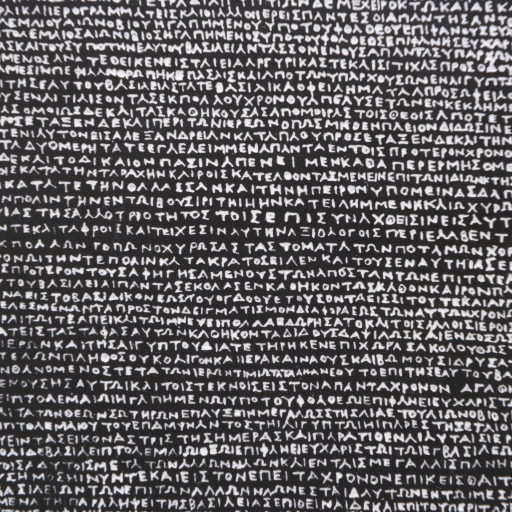It is impossible to know the exact origin of spoken languages. Languages evolved as humans moved and migrated. But evidence of written languages helps us to have a better idea of their history. Scholars generally agree that the earliest form of writing appeared around 6,000 to 5,500 years ago. Therefore, we could say it’s when everything started for translators!
Since then, knowledge and stories are transmitted from generation to generation. Writing has played, plays, and will play a key role in humanity. Written communication conveys the past in the present and helps plan the future. Let’s take coding. Is it not a type of language?
Written languages are a means of communication shaped and refined by cultural evolution. They form the base of translation. Translating is transcribing a written text from a source language into a target language. To better understand the art of translation, let’s dive into some fun facts about written languages.
What is the oldest written language system?
Humans keep records of history for a very long time, as evidenced by some of the oldest cave paintings in the world or other ancient artifacts. But it said that the first writing systems appeared with the first modern civilizations over 5,000 years ago.
While a few systems of symbols are considered older, the Cuneiform system is widely accepted as the world’s most ancient written language system. It’s a logographic and syllabic system type (or script) read from left to right. A few languages of the Ancient Middle East used it as their writing system.
The oldest attested written language, Sumerian, used this system. It’s an isolated language, which means it’s not related to any other existing language. The earliest known text dates back to 3200 BCE in Southern Mesopotamia. It continued to be used as a written language long after the spoken Sumerian disappeared.
What is the Rosetta Stone?
It is a stele composed of granodiorite inscribed with three versions of a decree issued in Memphis, Egypt, in 196 BC, by the King Ptolemy V Epiphanes: one in Ancient Egyptian using hieroglyphics, one in Demotic script and one in Ancient Greek.
The discovery of this stele in 1799 was key to translating Egyptian hieroglyphics. Because the three versions had the same message with only minor differences, scholars could decipher the Egyptian script.
The symbols represent objects from Ancient Egypt life. For example, symbols for plants, body parts and birds were used to create sentences.
The Egyptian Hieroglyphics are one of the oldest attested written languages, if not the 2nd.

Where comes from the alphabet?
Believe it or not, alphabetic writing started too about 4,000 years ago. Scholars agree that it emerged in Egypt around 1800 and 1900 BC. It was a Proto-Sinaitic writing form used to inscribe Sinaitic inscriptions on stones.
A few centuries later, people living near the Middle East, the Phoenicians, developed an alphabet based on this foundation. It contained 22 consonants and no vowels. Largely adopted by the different nations around the Mediterranean, the Greeks added the vowels around 750 BCE.
The Latins seized it and combined it with other characters. Then, the Romans created a derived version. They introduced it everywhere in their Empire. The structure changed and evolved up to the 16th century. It was when the modern English alphabet of 26 letters started.
Of course, alphabets are different from one country to the other. Not all contain letters. Some may include symbols or others.
What is an Alphabet?
Let’s start with the beginning. Do you know from where the word “alphabet” comes? The Greek alphabet. The first TWO letters, alpha and beta, form the word “alphabet”.
An alphabet is composed of the letters used by a language, organized in a fixed order based on the users’ customs. The alphabet is a writing system. Each symbol is a letter representing a sound or relative sound used by the spoken language.
All letters from an alphabet form words by following standards, such as reading directions, spaces, and punctuation marks. This structure is easy to read.
What is the smallest alphabet?
Rotokas is the smallest alphabet currently in use. It’s a Latin alphabet consisting of 12 letters only: A; E; I; G; K; O; P; R; S; T; U; V.
About 4,320 people speak Rotokas on the island of Bougainville, located in the east of New Guinea in Papua New Guinea. Most Rotokas people are literate in their tongue.
What is the longest alphabet?
As per the Guinness World Records, Khmer (Cambodian) is the language with the most letters, 74, including some with no current usage. It has 33 consonants, 24 dependent vowels, 12 independent vowels, and some diacritic symbols.
It’s one of the oldest alphabets in Southeast Asia too, with a fascinating history and a vocabulary influenced by Vietnamese, Thai, Lao, and French.
Which languages do not have an alphabet?
According to ScriptSource, 917 languages are not written. It’s probably a lot more when considering all the dialects and unofficial languages. Some say that more than half of all the languages in the world have no written form.
Some written languages do not have an alphabet, such as Chinese, Japanese, and Korean. However, they have an established writing system.
Traditional Chinese, or Mandarin, uses thousands of variations of glyphs. In the Chinese system, they separate meaning from sound. They use characters, also called hànzi, to write. These are logograms or single characters representing entire syllables, words, or units of meaning.
In comparison, letters do not hold meaning in phonetic languages like English. They represent different sounds, which, when combined, have a signification.
Japanese don’t have any alphabet too. They use three writing systems together: hiragana, katakana, and kanji.
Fun fact: Mandarin is the most used language worldwide. However, due to its tonal nature, nuances, and number of characters to memorize, it’s one of the most complex languages for English speakers to learn.
Did you know that translation is at the origin of some alphabets?
It’s a little-known fact. But it makes a lot of sense at the same time. Translators have been responsible for creating some alphabets when transcribing spoken languages into a written form.
The Cyrillic alphabet is a good example. It emerged from the work of Saints Cyril and Methodius. This alphabet is used today to write Serbian, Bulgarian, Russian, and other languages.
More recently, James Evans, an English Canadian Methodist missionary, invented the Cree syllabics around 1840 now used to write the most widely spoken Indigenous language in Canada.

What was the first language printed?
Despite popular beliefs, it’s in China where the earliest (first?) printing form was created, around 200 AD. It was called Woodblock printing. A design was carved into a block of wood. The raised part was inked. Finally, a piece of paper or fabric was placed on top.
A few centuries later, the German inventor Johannes Gutenberg started experimenting with printing in 1440. He had a printing machine ready to use commercially by 1450. Therefore, the first European language printed was German, as Johannes Gutenberg is designated the inventor of the printing press.
Fun fact: Tamil is the first non-European language to appear in print, both in its scripts and Roman transliteration. A Portuguese Jesuit missionary and scholar, Henri Henriques, travelled to India during the Portuguese colonial trade and worked there until his death. He produced five books printed in Tamil script and language.
What is an artificial language?
As per Merriam-Webster, an artificial language is devised by an individual or a small group and proposed for an international language or a more specific purpose, such as aptitude testing. But it’s not functioning as the native speech of its users.
In other words, it is not a way for people to communicate. These languages are created for books, movies, TV shows or computer programs (software, video game, etc.). More than 1,000 were proposed since the 17th century.
The “Klingon” language is a good example. It’s a constructed language spoken by a fictional alien race, the Klingons, in the Star Trek world, developed for the movie Star Trek: The Motion Picture.
What about programming languages?
A programming language is a written language too. It’s a system for writing computer programs with vocabulary and grammatical rules. Its goal is to instruct a computer or computing device to perform specific tasks.
Humans created their method of communication with computers, mainly developed as text-based formal languages. There are five major types of programming languages: procedural, functional, object-oriented, logic and scripting.
According to the Online Historical Encyclopaedia of Programming Languages, more than 8,950 coding languages exist. Here are some of the most popular ones: Python, Java, C++ and PHP.
What are the most popular languages over the Internet today?
Yes, we did go from stones to social media. Written languages in a new format. We can look at the most popular languages over the Internet from 2 perspectives: the number of Internet users by language and the content available in a given language.
The most used languages on the Internet by individual users
With little surprise, English comes first, followed in the top 5 by Chinese, Spanish, Arabic and Indonesian.
English is the leading language on the Internet. It’s not only because it’s the language used to create the Internet but also because the US and India are the 2 countries with the most Internet users after China. And many non-native English speakers seek out English web pages for convenience.
However, with more than 950 million native Mandarin speakers, more than 492 million native Spanish speakers, and growing access to the Internet, English could lose its first place in the years to come.
The most used languages on the Internet by content volume
From a content perspective, the top 5 slightly change and don’t reflect the world’s population.
English is still the leader, according to a survey from W3Techs, with 56.6%. Russian (5.1%), Spanish (4.7%), French (4.2%) and German (4.1%) come right after in this order, but with a much smaller content volume.
Fun fact: The Chinese language doesn’t appear in the top 10, despite counting the largest population in the world. Russian takes 2nd place due to the Russian-speaking online community. Russian is the native language of many countries of the former Soviet Union outside of Russia.

Other random fun facts
To conclude, we thought we would share some last fun facts. Written languages are fascinating. They did evolve with our civilization and culture. So, they carry their part of history up to today.
- Other than English, French is the second language taught in all countries.
- About 30% of English words come from French.
- People credit Shakespeare for inventing or introducing over 1,700 words, such as “kissing”; his work provided at least the first record of these words.
- The Korean dictionary counts the most words, with 1,1 million.
- The Pope tweets in 9 languages, with the Spanish channel being the most followed.
Written languages are complex and still evolving. Knowing their background is critical for understanding them and being capable of translating them accurately. It’s crucial to have some context to do the proper research, too.
From one language to the other, nuances, word construction, and grammar can influence the meaning of words, sentences, or characters. It’s why we recommend always hiring professional services for your translation needs.
A translation agency can organize translation into multiple languages and find the most qualified translator for your content and language pair.
At AOT, we take pride in our collaboration with our clients. We strive to be your partner in language solutions and navigate the complexity of languages with you.
Contact us to learn more at pm@aot.global.
References
https://takelessons.com/blog/2020/05/50-fascinating-language-facts-didnt-know-infographic
https://www.bestcolleges.com/bootcamps/guides/how-many-coding-languages-are-there/
https://www.languageinsight.com/blog/2021/20-amazing-language-facts-you-might-not-know/
https://www.internetworldstats.com/stats7.htm
https://www.optimational.com/blog/top-10-popular-languages-used-internet/
https://www.ulatus.com/translation-blog/10-amazing-facts-about-translation-and-languages/
https://langhotspots.swarthmore.edu/fastfacts.html
https://www.daytranslations.com/blog/origin-english-alphabet/
https://www.daytranslations.com/blog/the-smallest-alphabet-in-the-world/
https://languagedepartment.com/blog/the-longest-alphabet-in-the-world/
https://www.shakespeare.org.uk/explore-shakespeare/shakespedia/shakespeares-words/
https://www.ulatus.com/translation-blog/10-amazing-facts-about-translation-and-languages/
https://digventures.com/2013/10/friday-five-five-oldest-written-languages/
https://languagedepartment.com/blog/the-longest-alphabet-in-the-world/
https://www.calendar-canada.ca/faq/what-language-has-no-alphabet
https://www.ulatus.com/translation-blog/10-amazing-facts-about-translation-and-languages/
